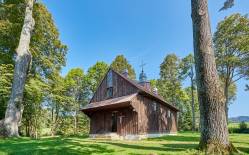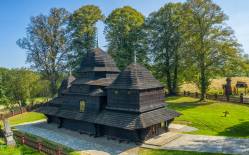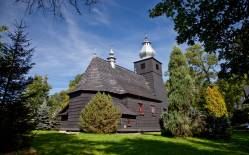The first record of a tserkva existing here dates from 1526. The present tserkva of St. Paraskevi was built in the late 1700s.
After the Ukrainian population was relocated from here in 1951, the tserkva was abandoned for a long time. Roman Catholics living in the village tried to acquire the building in the 1950s, however the authorities did not agree. Ultimately, the Roman Catholic Church acquired the building, which todays still functions as the parish church of Nativity of the Blessed Virgin Mary. Unfortunately, the appearance of the church was significantly affected by the renovation works conducted here.
The tserkva in Ustjanowa is a log structure, comprising three parts and oriented towards the East. The whole building is clad with shingles, and the porch – with wood planks. It is covered with gable roofs. Over the nave there is a turret topped with a Greek cross. Above the chancel there is a small pinnacle.
Inside there is a flat beam ceiling, and an overhanging gallery.
A fragment of the old iconostasis is in the holdings of the Museum of Folk Architecture in Sanok, however most of the old furnishings of the tserkva were lost in the 1950s. Today the most attractive feature inside is the rococo-style high altar from the 1700s brought here from the church in Hoczew. At the top of the altar, we can see sculptures of the Immaculate Virgin Mary as well as Adam and Eve standing at the Tree of the Knowledge of Good and Evil. The central panel holds a copy of the painting of the Holy Mother brought from Sokal by people resettled from that area to Ustjanowa. Inside we can also see a stone holy water font with the date 1862. An inscription on the rood beam says: Anno Domini 1792.
Near the tserkva we can see a tomb-shrine – damaged in the 1950s, as well as the old cemetery where only one tombstone has been preserved. A contemporary post-and-beam belfry stands next to the gate.
Photo: Krzysztof Zajączkowski
Gallery
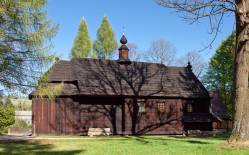
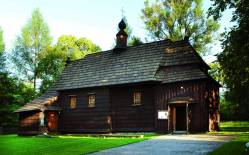
Recommended venues on the Trail



This website has been modernized with the financial support of the European Union under the Cross-Border Cooperation Programme Poland-Belarus-Ukraine 2014-2020. The responsibility for its content lies solely with the Podkarpackie Regional Tourism Board and cannot, in any case, be treated as a reflection of the position of the European Union, the Managing Authority, or the Joint Technical Secretariat of the Cross-Border Cooperation Programme Poland-Belarus-Ukraine 2014-2020.










